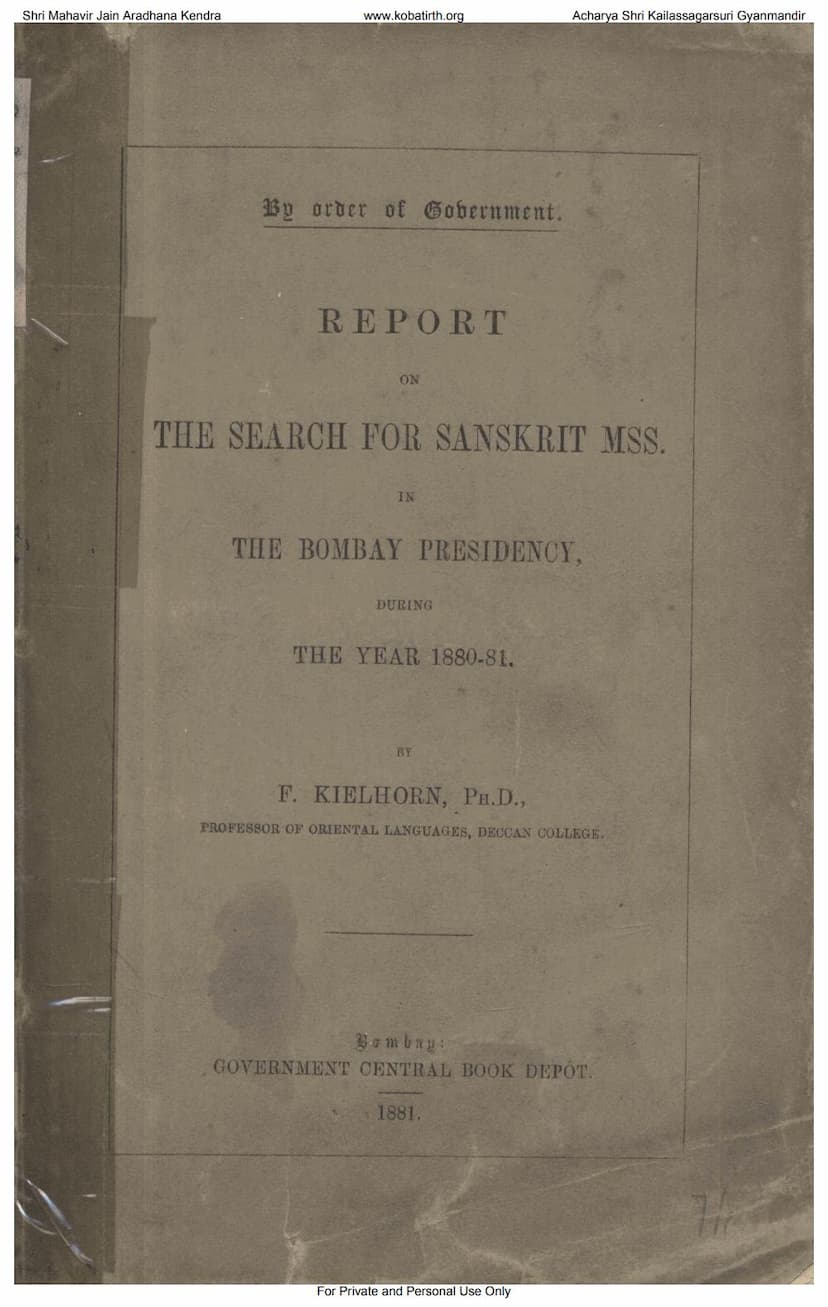Report On Search For Sanskrit MSS Year 1880 1881
Added to library: September 2, 2025

Summary
This document is a "Report On The Search For Sanskrit MSS. In The Bombay Presidency, During The Year 1880-81" by F. Kielhorn, Professor of Oriental Languages at Deccan College, published in Bombay by the Government Central Book Depot in 1881.
The report details the efforts made to locate and collect ancient Sanskrit manuscripts within the Bombay Presidency. Key aspects of the report include:
- Scope of Work: The work was initially divided between Dr. Bühler and the author, but after Dr. Bühler's departure, Kielhorn assumed responsibility for the entire search across both Northern and Southern Circles of the Presidency and attached territories. He also managed manuscripts collected since 1868 and housed at Deccan College.
- Methodology: The search was conducted under three main headings:
- Information Gathering: Collecting data on ancient libraries and searching for specific books.
- List Preparation: Creating rough lists or detailed catalogues of libraries likely to contain old or rare manuscripts.
- Purchase: Acquiring manuscripts for the Government collection.
- Key Discoveries:
- Jain Libraries: Four ancient Jain libraries were discovered in the Southern Circle, containing a significant number of paper and palm-leaf manuscripts.
- Northern Circle Efforts: Native agents undertook six tours in the Northern Circle, focusing on acquiring ancient palm-leaf manuscripts and searching for specific Vedic texts (Maitrâyaṇîya Sākhâ of the Yajurveda and Paippalâda Sâkhân of the Atharvaveda). While the search for the latter was unsuccessful, they obtained numerous works of the Saunaka Sâkhâ of the Atharvaveda and the Maitrayaṇiya Sâkhâ.
- Catalogues and Collections:
- Jain Libraries (Southern Circle): Rough lists of manuscripts from two Jain libraries were compiled. These lists contained many unique Jain works, prompting a decision to prepare more accurate catalogues for these and the other two discovered libraries. Some of these manuscripts were written in the Canarese script.
- Pathan (Anhilwad) Libraries (Northern Circle): Catalogues were prepared for a small private library (89 palm-leaf MSS., with dates ranging from Samvat 1186 to 1456) and the large Samghavi Bhandâr (527 palm-leaf MSS., with dates from Samvat 1120 to 1505). The report notes a surprisingly small number of manuscripts from the 14th century in the Samghavi Bhandâr, possibly due to political instability.
- Notable General Sanskrit Works Found: The report lists several manuscripts of interest to general Sanskrit scholars found in the Pathan collections, including works by Śâśvata, Hemachandra, Trilochanadâsa, Daṇḍin, Vâmana, Udayana, Vâcaspatimiśra, and others, with specific manuscript details like leaf count and dates.
- Purchased Manuscripts: A total of 413 manuscripts were purchased during the year (336 paper, 77 palm-leaf).
- Age and Preservation of Palm-Leaf MSS.: Kielhorn emphasizes the remarkable age of the collected palm-leaf manuscripts, with the oldest being precisely 800 years old (Samvat 1138 = A.D. 1081). He notes that these manuscripts were generally written during the 9th, 10th, 11th, 12th, and 13th centuries. He also highlights the excellent preservation of many of these manuscripts, contradicting the notion that Indian manuscripts do not last long. The report also details a system of ancient numeration found on these palm-leaf manuscripts, which used separate signs for digits, tens, and hundreds, and sometimes differed from previously documented forms.
- Manuscript Handling: Kielhorn personally examined each leaf of the palm-leaf manuscripts, reassembled mixed manuscripts, and ensured their preservation by placing them between wooden boards.
- Copyists and Value: The manuscripts were generally written with care. Remarks at the end of some manuscripts suggest that copyists were well-paid and that these manuscripts were valuable possessions centuries ago.
- Classification of Paper Manuscripts: The 336 paper manuscripts acquired were classified into categories such as Veda, Vedânga, Upanishads, Purâṇa, Poems, Plays, Fables, Grammars, Poetics, Philosophy, Dharma, Astronomy, Astrology, Medicine, Technical books, Mantra-tantra, and Jaina works.
- Total Government Collection: At the time of the report, the Government collection comprised 2,904 manuscripts, including those in Kashmiri, Hindi, and Persian, along with approximately one thousand Jain manuscripts and the rest Brahminical. It included 81 palm-leaf manuscripts.
- Manuscript Loans: 99 manuscripts were on loan to scholars in Europe and India. A list of these scholars is provided.
- Appendices: The report includes a detailed description of the palm-leaf manuscripts (Appendix A) and a classified list of the paper manuscripts acquired during the year (Appendix B).
- Expenditure: The total expenditure for the search during 1880-81 was Rs. 6,728-7-9.
- Concluding Remarks: Kielhorn expresses hope that the year's results are favorable and that the collected works will be valuable for scholars, particularly in the fields of Jain religion and literature. He also mentions his personal efforts in arranging and cataloging the acquired manuscripts to make them accessible.
The latter part of the document (from page 16 onwards) provides detailed descriptions of the collected Palm-Leaf MSS. and subsequently the Paper MSS., including their titles, authors, number of leaves, size, lines per page, and often the year of compilation or acquisition. The Jain works constitute a significant portion of the listed manuscripts, indicating a strong focus on their preservation and study. An appendix also lists manuscripts collected in a previous year (1873-74).